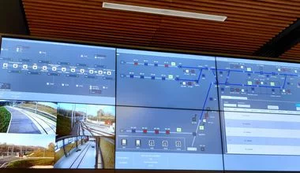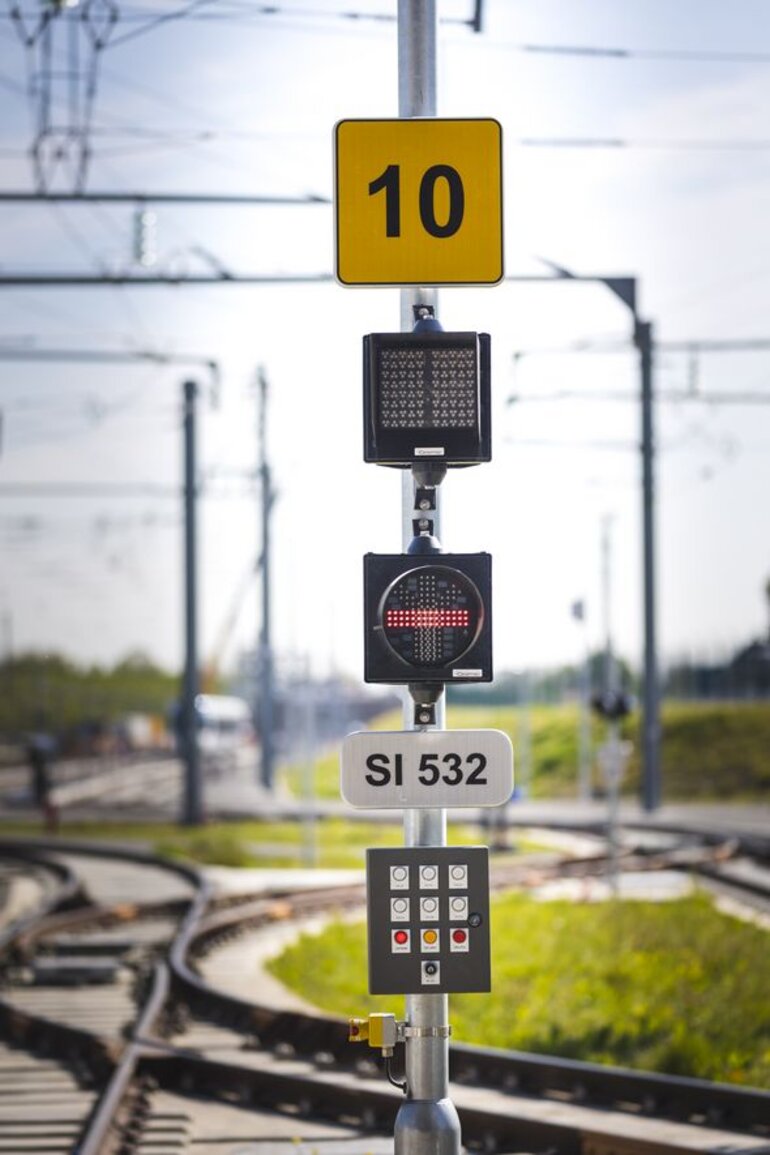TRAMWAY SIGNALING PROJECTS
SNCF and Île-de-France Mobilités to start relying on HIMA controllers
A new way of thinking in regional transport policy is leading to a revival of electric tramway concepts that were long thought to be dead. If the previously isolated streetcars can be linked to the rail network, an important goal in regional planning will have been achieved. Standardized and mass-produced safety controllers help by combining SIL4-level safety with low investment costs, as the example of the new T12 and T13 lines in the Paris metropolitan area shows.
On January 12, 1913, the people of Paris sent their last horse-drawn streetcar to the storage depot for good. Apparently, during the economic boom after the Second World War, the mayors still had horses in mind when deciding the fate of the now electrified streetcars. In any case, they turned up their noses and once again banished the local means of transportation on above-ground streetcar tracks to the depot. There they remained for the time being and individual transport was given priority in the inner cities of Europe for many decades to come. While around 1945, tramways were still in operation in some 500 European cities, three decades later hardly any cities in Great Britain, France, Spain, Portugal or Italy used this means of transport for their citizens. 320 networks had disappeared from the timetables of European cities.
Today, the situation is being re-discussed in many places. The advantages of urban rail transport are being seen and disadvantages are being actively addressed. It is clear that construction and operation are significantly cheaper and more environmentally friendly than subways. Tramways are also generally faster, more punctual and lower in emissions than buses. Although initial investment is significantly lower than for subways, above-ground expenditures for rail tracks, necessary depots and workshops can quickly reach half a billion euros. Added to this is the lack of compatibility due to different rail systems or track gauges, which makes continuity difficult. The traditionally very complex signaling systems also require high expenditures for the corresponding technology.
Mobility-as-a-Service using the example of Paris
In the meantime, the benefits of the cozy cabins on rails has convinced politicians, spatial planners and city councils, leading to a renaissance of the tramway. This is also true for Paris and the greater Île-de-France area, a conurbation that until the 1990s had woven its network almost exclusively from metro, regular bus and commuter trains. Then, growing pressure from steadily increasing user numbers and congested roads in many places changed the mood back toward Tramways. With the aim of adding more affordable hubs to the network, they too have been supplementing the timetables of Parisians' again since 1992. Today, more than a million passengers in the metropolitan region once again use this classic mobility service every day - and the trend is rising.
The expansion of the Parisian route network with the help of the Tramway follows a strategic decision by the operator Île-de-France Mobilités (IDFM): to implement the ambition of Mobility-as-a-Service (MaaS). From the company's perspective, this includes acting as a player in service-oriented mobility and offering travelers a digital MaaS ecosystem. To achieve this goal, the French are investing not only in digital infrastructure but also large sums in the physical expansion of rail services: As part of the mobility program, two new lines in the greater Paris area are about to be officially launched.
Operator IDFM and SNCF are building networked systems
In the west and southwest, operator IDFM and transport company SNCF are building the T12 and T13 lines. The special feature is the networking of the previously separate tramway and train systems: The T12 will run on a rail line in the Massy - Épinay-sur-Orge section and take over a section of the commuter rail line here. And the T13 will also use adapted multi-system vehicles so that the existing vehicles can be transferred to the other system. This will create transfer-free direct connections between inner-city streetcar systems and regional rail lines.
This goal poses a number of challenges for the project partners in addition to licensing aspects: The personnel must be trained as train drivers and tramway drivers, wheel tires must be matched to points and the width of the grooved rails. Electricity system, clearance gauge, platform height, lighting and warning signals have to be considered. The new cars of the T12 and T13 lines therefore have the characteristics of both a tramway (clearance gauge, acceleration, braking) and a train (maximum speed, safety equipment on board).
The heart of safety technology beats in the depots
A particular focus of the T12/T13 project was on safety technology. To ensure that the tramways could operate under perfect safety conditions, a central control center was set up in the respective depots Massy (T12) and Versailles (T13), the latter just a few hundred meters from the Louis XIV Palace.
In addition, those responsible decided to set up a manufacturer-independent railroad signaling system. The classic PIVOS and PRS systems, although functionally suitable, would have been far too expensive and too complex to implement. This observation, together with numerous references, led SNCF to decide to use "city" type signaling systems, resulting in a significant reduction of CAPEX with complete freedom to control OPEX by choosing the adapted maintenance strategy compared to existing solutions (PIVOS or PRS).
"When building the two new depots for the T12 and T13 tramway, our goal was to equip them with a signaling system that would meet all the needs of the operation: cost-optimized and, at the same time, completely safe. However, the classic PIVOS and PRS systems, although functionally suitable, would have been far too expensive and too complex to implement."
Safety according to SIL4/ CENELEC
Mobility Signalling implemented the turn-key signaling systems for these two railroad projects on behalf of SNCF, based on SIL4 level safety controllers according to CENELEC from the safety experts of the manufacturer HIMA. The certified programmable safety controllers are offered by HIMA as commercial-off-the-shelf (COTS) products that provide end users and solution providers with independence, flexibility and cost savings, and can be easily integrated and maintained in a wide variety of solutions. At their core, HIMA systems provide functional safety and IT security in applications such as level crossings, interlockings, power protection and rolling stock.
"It is a completely open system that is also not Mobility's property. This allows SNCF to further develop the system, or to hand over further development to third parties.
The equipment we use has all the guarantees in terms of level of safety and longevity. And it is important to stress that this signaling system is connected to the national rail network (RFN) via an interface whose principle was developed by SNCF, implemented by Mobility and finally validated by SNCF experts."
Doubts were quickly dispelled
At the beginning, this approach did not meet with unqualified approval in the very tradition-loving rail industry: "This new and innovative approach caused certain doubts on the part of SNCF at the beginning," recalls Vincent Rocca, Systems Operations Manager at SNCF. But now, at the end of the project, he draws a positive conclusion:
-
The teams, which originally came from urban transport, learned to adapt to the SNCF railroad environment
-
The team contributed with suggestions and the system proved its performance
-
The schedule was met
-
SNCF now has a competitively priced signaling station that meets SIL4 level and can interface with the national rail network
And Stéphane Berthet, corporate director of Mobility Signalling, also sees only winners: "Our confidence at Mobility has been for many years that the technologies used in urban areas, i.e. metro and tramway, are also suitable for heavy rail infrastructures interconnected with the national rail network. This project proves that, setting a precedent for engineering centers, utility corridors, ITEs, ports, and sparsely populated regions."
Overall, this reduces acquisition and operating costs, allows the equipment to be up and running quickly, and provides a controlled interface to the national rail network - all without being trapped in a proprietary solution.
The turn-key solution approach i.e. design, set-up, works, commissioning by a single solution provider is a completely new approach for SNCF. Also, the maintenance strategy is no longer a critical aspect that would be tied to one solution provider. The operator can choose the appropriate strategy depending on his needs and resources. And the openness of the system means that the operator can be confident that the system can be updated and changed, and not just by the solution provider.
Static testing of the T12 depot has been completed since November 2021, with dynamic testing accomplishment scheduled for March 2022. T13 depot dynamic testing already achieved. Full approval with national network interface of the T13 depot will also follow in January 2022, with commercial launch of T13 Tramway scheduled in July 2022 and T12 Tramway earlier by end of 2023.
To be sure, tramway projects like these in Paris are not yet enough to put all the once-vanished 320 networks in Europe back on the maps. But one thing is certain: with increase of mobility needs in big cities, development of the MaaS and decarbonization challenge, high performance tramway will definitively play major role in reaching challenges of tomorrow.
Safe and certified
For signaling systems, interlockings, level crossings or rail vehicles: depending on the requirements, the HIMatrix or HIMax safety controller is best choice. HIMatrix is a compact system that can be used both centrally and decentrally. It can withstand temperature ranges from -25° C to +70° C. HIMax is used in larger applications such as complete railroad stations. Redundant architectures can be set up with this controller: Even if one controller fails, the safety system continues to operate. With these COTS systems from HIMA, customers save almost a third of their costs for interlocking solutions. Both HIMatrix and HIMax are already pre-certified by German TÜV and can therefore be used without additional testing. If applications are subsequently changed, the HIMA hardware does not need to be re-certified.
HIMA controllers meet all relevant railroad standards according to CENELEC:
- EN 50126 for the overall system
- EN 50128 for software
- EN 50129 for hardware
- EN 50155 and IEC 61373 for rolling stock applications
DEPOT AND CONTROL ROOM
The heart of the T12 and T13 lines
In addition to the depot, the maintenance and stabling yard (SMR) includes a large maintenance workshop and a control center. Its main task is to control and regulate traffic, support drivers, ensure safety and inform passengers, but also to manage incidents. Beyond the operation of the tramway, it will be manned 24 hours a day, 7 days a week, to monitor all interventions on the line, especially maintenance work on the tracks. The control center will be operated by about ten people: tramway dispatchers, passenger information staff, security personnel and a supervisor.
Depot performance in figures
Depot T12/SMR Massy
- Capacity of 29 simple units
- 23 switches, 29 signals, 38 short track circuits, 5 optical safety barriers
- One connection to the national railroad network (RFN)
- Planned extension of the depot for a second connection to the national railroad network
- Capacity performances: 79 simple routes and 384 composite routes


Depot T13/SMR Versailles
- Capacity of 12 simple units
- 13 switches, 8 signals, 8 short track circuits, 1 axle counter
- One connection to the national railroad network (RFN)
- Planned expansion of the depot to double capacity
- Capacity performances: 17 simple routes and 13 composite routes


Long-term cooperation
Mobility Signalling has been successfully using HIMA PLCs in French networks for several years:
- Lyon, Meyzieu depot, 2005
- Luxembourg, line 1 and depot (+ 3 extensions) since 2017.
- Nice, line 2 and 3 and depot, since 2018
- Caen, line 1, 2 and 3 and depot, since 2019
- Bordeaux, extension of line to airport in progress




